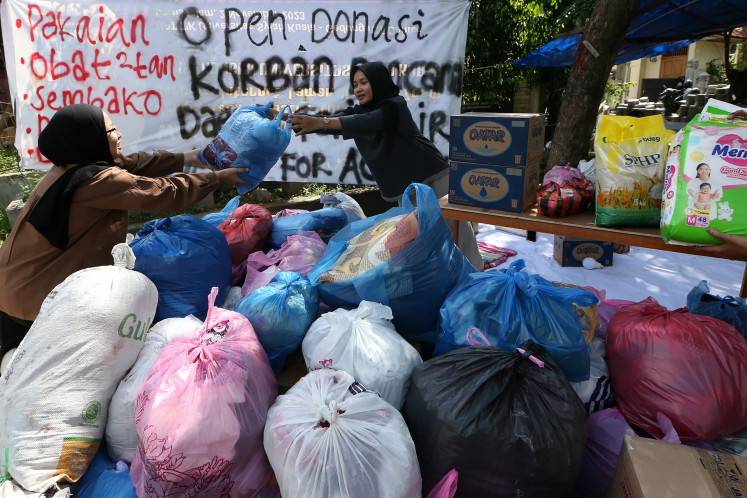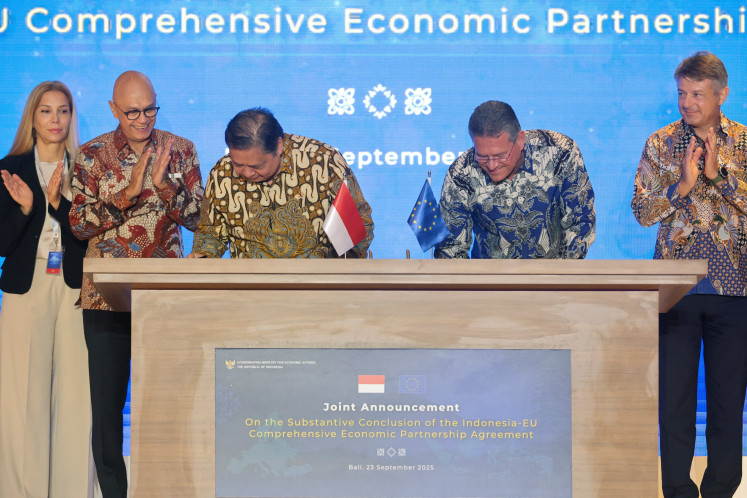Popular Reads
Top Results
Can't find what you're looking for?
View all search resultsPopular Reads
Top Results
Can't find what you're looking for?
View all search resultsBanks starting to lend less, and seeking safety more: BI
Banks are starting to reduce lending and to seek safety in short-term central bank certificates as Indonesia is hit harder by the global economic crisis, says latest BI data
Change text size
Gift Premium Articles
to Anyone
Banks are starting to reduce lending and to seek safety in short-term central bank certificates as Indonesia is hit harder by the global economic crisis, says latest BI data.
According to newly released Bank Indonesia (BI) banking statistics, outstanding loans fell to
Rp 1,289.84 trillion (US$107.26 billion) in January from Rp 1,307.69 trillion in December. The total volume of January loans outstanding was the lowest total loan portfolio figure in the last four months.
Placements by banks at BI rose Rp 24.51 trillion to Rp 346.84 trillion in January from Rp 322.33 trillion in December, according to the report.
Of this amount, short-term BI certificates, or SBIs, attracted Rp 208.51 trillion in January, a Rp 41.99 trillion increase on total holdings of Rp 166.52 trillion in December.
Meanwhile, the level of third party funds slid to Rp 1,748.81 trillion from Rp 1,753.29 trillion.
“Companies are slowing their expansion and even those (financial institutions) with loan facilities are putting investment on hold,” said Thauriq Anwar of PT Valbury Securities, as quoted by Bloomberg on Thursday.
(JP/Irma)
The decline in loan channeling has sent out a wake-up alarm call for the economy as companies have less room to expand due to lower demand, and interest required on loans offered by banks is still considered too expensive, despite BI’s recent policy to significantly reduce benchmark interest rates.
While average lending rates have shown a slight decrease between December and March, according to BI, the rates remain unattractive for companies because they are still reorganizing their businesses to anticipate future uncertainties.
This year, BI has cut its benchmark interest rate by 150 percentage points to a near four-year low of 7.75 percent. But banks have yet to follow suit and pass on interest reductions.
Analysts have said lending rates below 13 percent would still keep the economy running at the targeted 4.5 percent economic growth.
BI data reveals only a slight decline in lending rates from an average 14.2 percent in the last week of December 2008 to 13.93 percent by the second week of March, while deposit rates declined from 8.75 percent to 8.32 percent.
President Susilo Bambang Yudhoyono has urged the banking industry to lower lending rates to help drive the economy, which is now relying heavily on domestic consumption and government spending.
Finance Minister Sri Mulyani Indrawati said Wednesday the government had required state banks to initiate steep interest rate cuts.
A lower BI rate is expected to prompt banks to cut lending rates, which will ease business costs and spur demand for loans from consumers to purchase cars, motorcycles and houses.
Since the 1998 Asian financial crisis, around 70 percent of Indonesia’s economy has usually been driven by domestic consumption.
BI deputy governor Muliaman D. Hadad said that in normal times, banks would need two to three months to adjust lending rates to new BI rates.
However, he said banks would have difficulties to immediately lower their rates as they needed to balance their third party funds, interest margins and guard against the threat of soaring non-performing loans.
BI estimated lending growth would slow to between 14 percent and 16 percent this year, compared to 30.5 percent in 2008.










